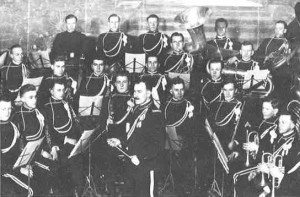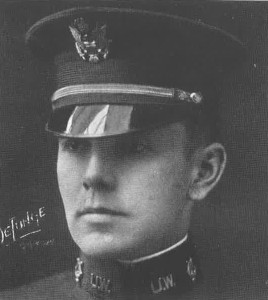In 1884, the band was increased to 16 players. On February 1, 1886, the band made its first non-military appearance at the 10th Annual Joint Debate of the university. The leader of that band was listed as C.M. Williams.
Membership of the band dwindled to 11 members in 1888. During 1889 and 1890, under the direction of Lieutenant J.A. Cole, we find no mention of a band. However, records do credit a bugle corps doing military work during this time. In 1891, the band was reorganized with 19 members and directed by Spencer Beebe. During the next few years, the size of the band varied from 16 to 23 players and was known by a variety of names: The University of Wisconsin Band, The Varsity Band, and The University of Wisconsin Battalion Band.
By 1894, a more general type of band had gained support. Consisting of 26 men, the university band was formed to play for university football games. Members of the band from 1894 to 1896 often referred to themselves as the “first official University of Wisconsin Band,” but that was sometimes amended to the “first official military band.” This was possibly due to the fact that in 1897 the leader E.C. May, no relation to F.O. May, was given lieutenant straps. According to May, “We played in military uniforms for the regular drill and stuck to the uniforms for football games and the junior prom for which the band played the whole darn program, for better or worse, in the old armory on the lakeshore.”

Director
1908-15
May left Wisconsin after three years to begin a successful career as a businessman and writer. O.W. Joslin followed May as director. In 1899 Professor Charles Nitschke was appointed director of the band. Beginning with 25 men, membership increased to 36 members in 1900. In 1901, the band was referred to as the “University Regimental Band,” a title retained until 1914. Captain H. E. Owen was appointed instructor and director of the band in 1905, and in 1909 was succeeded by Charles A. Mann. Mann, a member of the chemical engineering faculty, directed the university band from 1908 until the end of the summer session in 1916. Under his direction the band grew in size from a mere 40 men to an enrollment of more than 100.
During the 1912 school year, a second band was organized as a recruiting body. This 30-piece group was was conducted by J.E. Saugstad. By 1914, the military activities of the university reached such proportions that a second regiment was added. This necessitated two bands; therefore, the ”Second Regiment Band” was formed. The membership of the first band was 50 members, while the musicians in the second band numbered 40.
In the summer of 1915, with impetus given by Charlie Mann, the school year culminated in a unique trip by the First Regiment Band. The band traveled well over 7,000 miles through 14 states, making 100 appearances, performing eight different programs, on their way to the Panama Pacific National Exposition in San Francisco. The trip, which has become one of the most famous trips the band has ever taken, was spearheaded by Saugstad, who had labored for two years on the project while receiving little or no encouragement for the project.

In 1918, W.E. Yates assumed the responsibility of the band. Little is known about Yates; nevertheless, he managed to keep the band department “healthy and intact” during the unsettled years following World War I.

Director
1920-34
When Charles Mills, director of the School of Music, brought Edson Morphy to Madison to assume leadership of the band department in the fall of 1920, there began a new period in the development of the Wisconsin Band. When Morphy took the leadership of the Wisconsin band department, it appeared he had two goals. One was to raise the musical level to the highest degree possible. A second was to redistribute the performance responsibilities of the two bands at the school. He also set about to release the members of the Concert Band from any marching or ROTC obligations. There appears to be no formal structure in regard to the size of the marching band. Reports of the day reveal that for one game there might be 165-200 marching musicians, but a week later there might be only 100.
Enrollment in the Band had suffered greatly in the 1918-1919 school year, due to the large number of students who had entered the armed forces. During the war years, the enrollment in Band had decreased to about 45 men. Morphy made a concerted effort to increase the musicians in the band program. One university regulation that may have stimulated the participation in the band program was that “male students must choose physical training, military training, or band.”
In 1928 it was announced that “all football engagements will be handled by 100 men, thus sparing the concert men from jamming their lips on the football field and allowing them to settle down into the concert mood directly at the start of the school year.” Now the band department had finally reached the structure Morphy had sought: The Concert Band and the Second Band were separate organizations, each with its own identity and objectives. This was the beginning of the band department structure that was to continue to the present.
Morphy also had an intense aversion to jazz and to the saxophone. He allowed no saxophones in his band, and regularly assigned the saxophone parts to alto and bass clarinet. Any student who approached him about playing the saxophone was provided with the name of an instructor who could give him lessons on another instrument.
